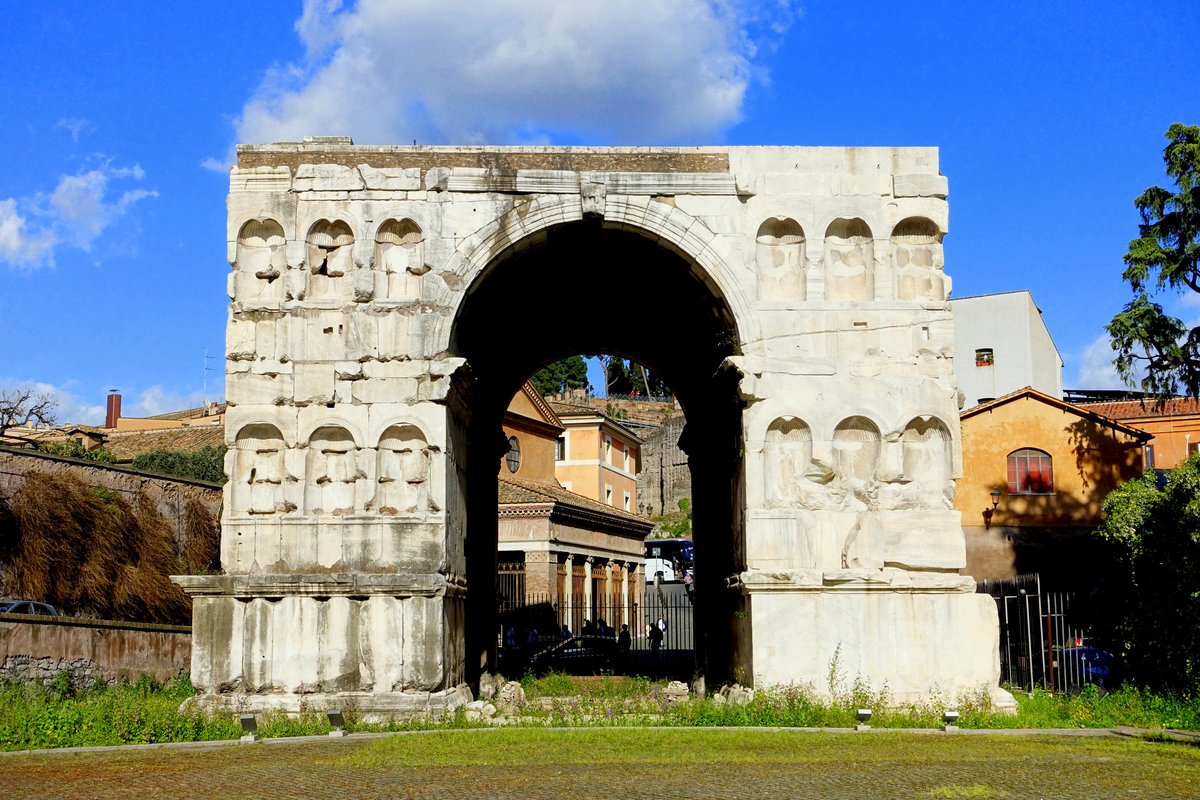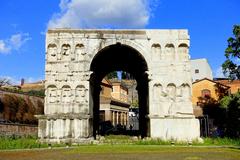
Visiting the Arch of Janus, Rome, Italy: Complete Guide
Date: 14/06/2025
Introduction to the Arch of Janus
Nestled in the heart of ancient Rome near the historic Forum Boarium, the Arch of Janus is a unique monument, distinct from the city’s more famous triumphal arches. Built in the early 4th century CE, this quadrifrons (four-faced) arch stands as a symbol of transition and connectivity, reflecting both the physical crossroads of ancient Rome and the spiritual associations of Janus—the Roman god of beginnings, gates, and transitions. Constructed primarily from spolia, or repurposed marble from earlier buildings, the arch not only showcases late imperial architectural practices but also captures the shifting artistic and economic climate of late antiquity.
Today, visitors can admire the arch’s imposing structure, complete with 48 niches that once held statues, and observe remnants of both ancient utility and medieval adaptation, when the arch was incorporated into local fortifications. While the interior remains fenced off to protect the monument, the Arch of Janus is freely accessible for public viewing at any time. This guide offers comprehensive historical context, architectural analysis, visitor information, and practical travel tips to ensure a rewarding encounter with one of Rome’s most evocative ancient sites.
For further details and updates, consult resources such as Rome Reborn, Archaeology Travel, and Rome’s Official Tourism Website.
Contents
- Introduction to the Arch of Janus
- Origins and Construction
- Architectural Features and Symbolism
- Historical Context and Urban Role
- Medieval and Modern Transformations
- Preservation and Current Status
- Visiting the Arch of Janus: Hours, Tickets, and Accessibility
- Travel Tips and Nearby Attractions
- Visuals and Media
- Frequently Asked Questions (FAQ)
- Conclusion
- Sources
Origins and Construction
The Arch of Janus was erected in the early 4th century CE, likely during or just after the reign of Emperor Constantine I. Its exact date and original purpose remain debated, but it is generally agreed that the arch served as a monumental gateway at the intersection of two important roads: the Via Lata and the Vicus Jugarius (Rome Reborn). Unlike the more common triumphal arches, the Arch of Janus was not constructed to commemorate a military victory but rather to mark a major urban crossroads and perhaps provide shelter for merchants in the adjacent cattle market of the Forum Boarium.
The monument stands about 16 meters high and 12 meters wide, built from massive marble blocks repurposed from earlier imperial buildings—a practice reflecting both resourcefulness and changing artistic priorities in late imperial Rome (Musei Capitolini). The four identical facades, each with a large central archway and rows of niches, allowed movement in all directions and emphasized the structure’s role as a true crossroads.
Architectural Features and Symbolism
Quadrifrons Design
The Arch of Janus is the only surviving quadrifrons arch in Rome. This four-way design is exceptional in Roman architecture and is thought to symbolize the all-seeing, transitional nature of Janus, who presided over beginnings, gates, and doorways (UNESCO World Heritage).
Niches and Lost Decoration
Each of the four facades features 12 niches (48 in total), originally designed to house statues—possibly of gods, emperors, or personifications of virtues. The keystones display reliefs of deities such as Minerva, Ceres, Roma, and Juno, although some are now damaged or lost (Jeff Bondono). The now-missing attic, removed in the 19th century, may have once supported additional statuary or inscriptions.
Materials and Construction
Built atop the ancient Cloaca Maxima, the arch’s core consists of brick and Roman concrete, with a marble veneer (much of which is now lost). Numerous holes on the surface show where iron pins once attached the marble cladding, testifying to centuries of spoliation and adaptation (Archaeology Travel).
Historical Context and Urban Role
Located at the edge of the Forum Boarium, the city’s cattle market, and near the Tiber River, the Arch of Janus played a practical role in ancient Rome’s urban infrastructure. It may have served as a boundary marker, a monumental gateway, or even a shelter for traders and travelers. Its location above the Cloaca Maxima highlights its integration with Rome’s vital urban systems (Rome’s Ancient Monuments).
Unlike triumphal arches, the Arch of Janus did not celebrate a specific victory or emperor but embodied the city’s cosmopolitan character—its crossroads, both literal and metaphorical.
Medieval and Modern Transformations
During the Middle Ages, the powerful Frangipane family incorporated the arch into their defensive walls, bricking up its passageways for security (Rome Art Lover). This adaptation likely contributed to its survival, as many pagan monuments were destroyed or quarried for materials. In the 19th century, restoration efforts aimed at returning the arch to its ancient appearance inadvertently removed the attic, mistakenly believed to be a later addition (Jeff Bondono).
The arch has witnessed bomb damage, environmental wear, and ongoing conservation challenges. Restoration and stabilization efforts continue, with the monument added to the World Monuments Fund Watch List in 2016 (Archaeology Travel).
Preservation and Current Status
Today, the Arch of Janus stands as a powerful symbol of Rome’s layered past. Although fenced off to protect it from further damage, it is fully visible from the surrounding streets and remains a prominent feature of the Forum Boarium district. Conservation focuses on stabilizing the structure and mitigating environmental damage (Rome’s Official Tourism Website).
Visiting the Arch of Janus: Hours, Tickets, and Accessibility
- Visiting Hours: The monument is outdoors and can be viewed at any time. Interior access is not permitted due to preservation measures.
- Tickets: No entrance fee; the Arch of Janus is freely accessible from the street.
- Accessibility: The site is accessible by foot and close to public transportation, including bus stops and the Circo Massimo metro station. The area is mostly flat but some uneven pavement may present mild challenges for those with mobility issues.
Travel Tips and Nearby Attractions
- Best Time to Visit: Early morning or late afternoon for optimal lighting and fewer crowds. The arch is attractively illuminated at night.
- Nearby Attractions:
- Temple of Hercules Victor and Temple of Portunus—two well-preserved ancient temples in the Forum Boarium.
- Church of San Giorgio in Velabro—adjacent to the arch and notable for its historic architecture.
- Bocca della Verità (Mouth of Truth) and Tiber Island—within short walking distance.
- Circus Maximus and Roman Forum—major sites easily reached on foot.
- Photography: Best photographed from the embankment of the Tiber or the open areas of the Forum Boarium.
Visuals and Media
For an enhanced visitor experience, seek out virtual tours and high-resolution images online. The arch is often featured in interactive maps of Rome’s ancient sites, and informational plaques at the site may offer QR codes linking to additional content.
Frequently Asked Questions (FAQ)
Q: Is there an entrance fee for the Arch of Janus?
A: No, the monument is free to visit and visible at all times.
Q: Can I go inside the Arch of Janus?
A: No, interior access is restricted to preserve the structure.
Q: What are the best times to visit?
A: Early morning or dusk for the best light and quietest atmosphere.
Q: How do I get there?
A: Walk from the Roman Forum or Circus Maximus, or take public transport to Via del Velabro.
Q: Are guided tours available?
A: Some walking tours of ancient Rome include the arch; private guides can offer deeper context.
Summary and Final Recommendations
The Arch of Janus stands as a singular testament to Rome’s ingenuity, resilience, and complex history. Its unusual quadrifrons architecture, strategic location, and centuries of adaptation offer a window into the city’s ever-changing urban landscape. Whether you are captivated by its mythological associations, its role in ancient Roman infrastructure, or its survival through medieval and modern times, the arch is a must-see for those exploring Rome’s lesser-known treasures.
Pair your visit with nearby ancient sites for a richer understanding of Rome’s layered past. For updated visitor information, guided tours, and travel advice, consider using the Audiala app and official tourism resources.
Explore the enduring legacy of the Arch of Janus and discover why this unique monument remains a powerful symbol of transitions, both in Rome and beyond (Rome Reborn, Archaeology Travel, The Elemental Mind).
Sources
- Arch of Janus, Rome Reborn, 2025
- Arch of Janus in Rome, Archaeology Travel, 2025
- Arch of Janus, Musei Capitolini, 2025
- Arch of Janus, Rome’s Official Tourism Website, 2025
- Understanding Janus, The Elemental Mind, 2025
- Arch of Janus, Rome’s Ancient Monuments, 2025
- Arch of Janus, Jeff Bondono’s Tourist in Rome Guide, 2025
- Arch of Janus, World History Edu, 2025
- Arch of Janus, Rome Art Lover, 2025
- Arch of Janus, Oxford Classical Dictionary, 2025


















































































































































































































































